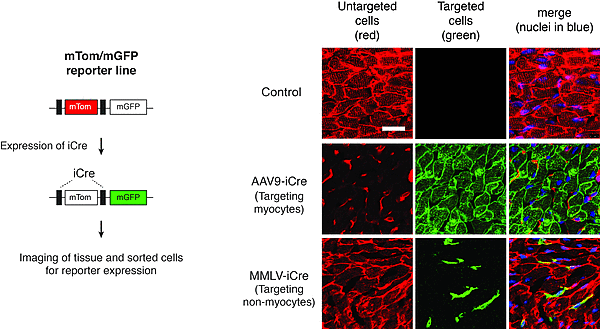Differential targeting of myocardial microRNA using viral vectors
Team: Deepak Ramanujam, Anne Dueck, Sabine Brummer
MicroRNAs are potent regulators of mRNA stability and translation, and have been found to be critically involved in cardiac remodeling, either with disease-promoting or protective activity. Our team has developed a viral vector-based strategy for gene targeting in both cardiac myocyte and non-myocyte cells.
An important microRNA in regulating cardiomyocyte hypertrophy (enlargement of muscle cells) appears to be miR-378, which was identified in a screening approach using multiple synthetic microRNAs (Jentzsch et al., JMCC, 2012). Restoration of disease-associated loss of miR-378 levels using an adeno-associated virus (AAV)-mediated CM-targeted approach provided cardioprotection by exerting its anti-hypertrophic action on MAP kinase pathway factors (Ganesan et al., Circulation, 2013).
MiR-21 was previously identified as a microRNA that is strongly upregulated in failing myocardium in humans and its systemic inhibition using synthetic molecules prevented myocardial fibrosis and dysfunction (Thum et al., Nature, 2008). However, studies in cardiac myocytes suggested a protective role for miR-21 in this cell type. With targeted approaches using AAV and murine moloney leukemia (MML) viral vectors, we demonstrated that miR-21 exerts its pathologic activity in cardiac non-myocytes (Ramanujam et al., Mol Ther, 2016).
Our team elucidates the function of microRNAs in different cardiac cell types that may help in understanding cellular processes, intercellular communication and encourages development of microRNA therapies toward cellular tropism.
References:
Thum, Gross et al., Nature 2008
Jentzsch et al., JMCC 2011
Ganesan et al., Circulation 2013
Ramanujam et al., Mol Ther 2016


